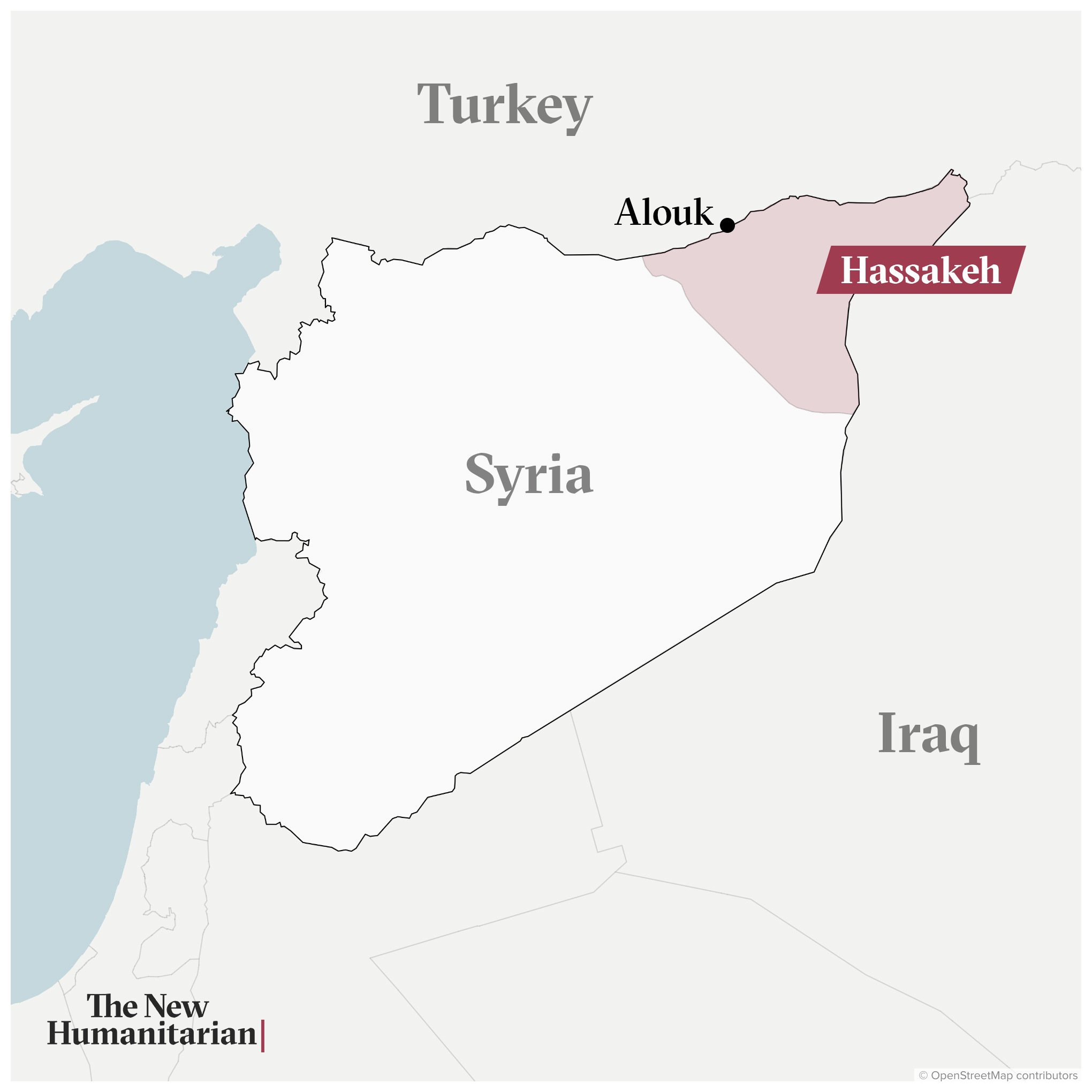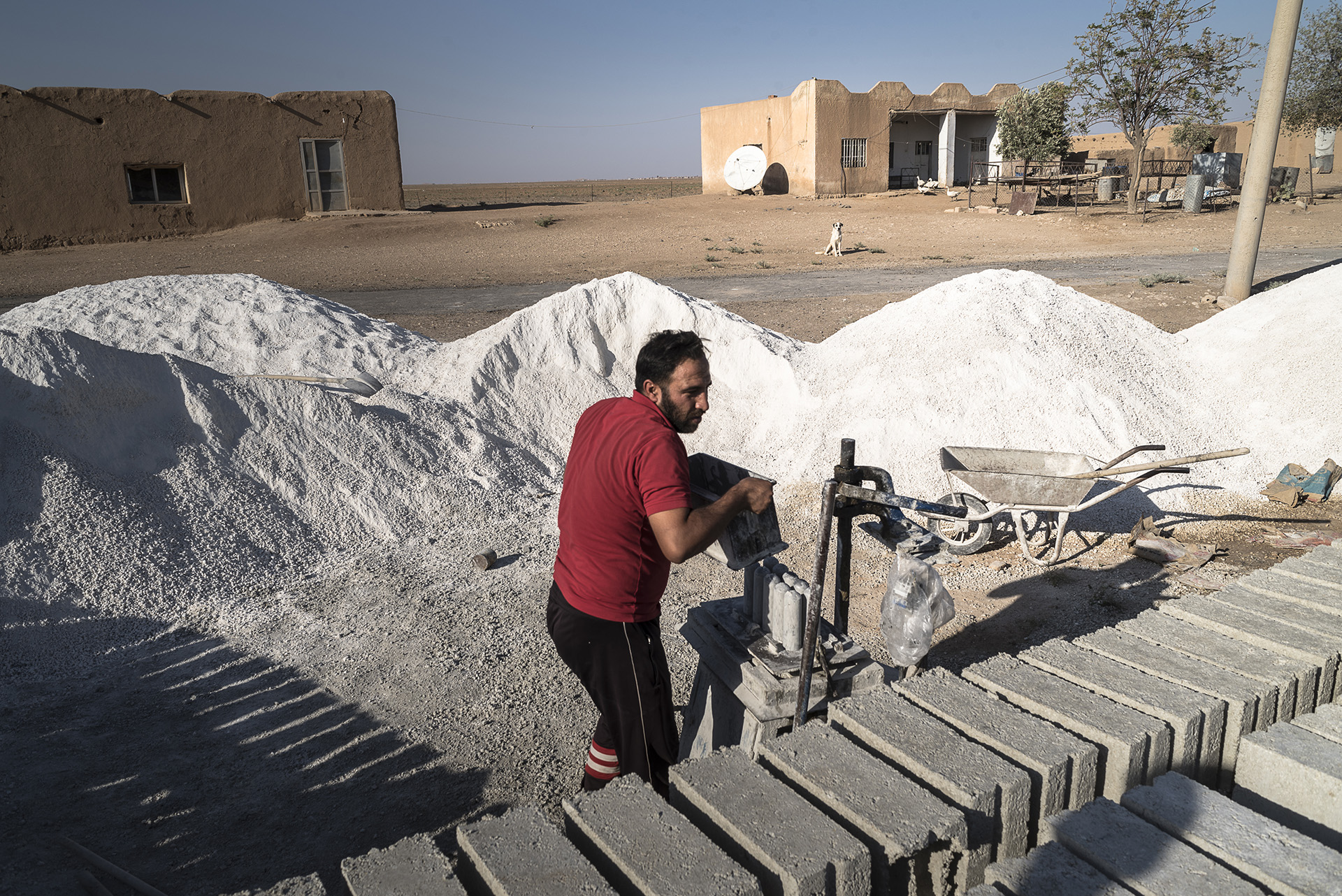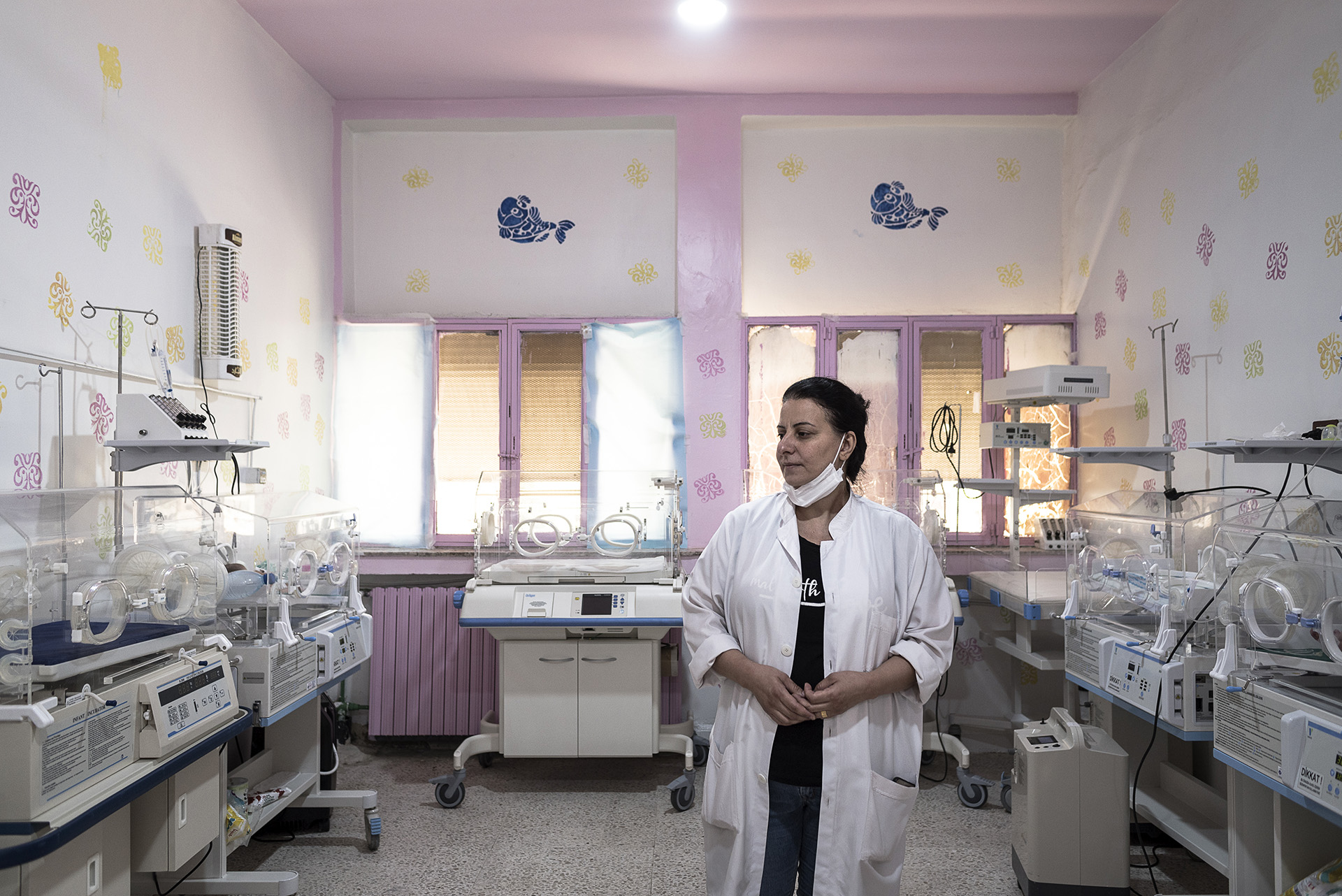The huge silos at the roundabout as you enter Syria’s Hassakeh city are decorated with giant pictures of Abdullah Öcalan, leader of the Turkey-based separatist Kurdistan Workers Party (PKK), as well as flags from the military arm of the local Kurdish-led administration.
There is still some corn in the silos, but by next year they might well be empty. A dangerous combination of climate change and politics – neighbouring Turkey controls the closest water station and opposes the Kurdish-led government because of its ties to the PKK, which it considers terrorists – is driving water and electricity shortages, and raising concern over the food supply for millions in northeastern Syria.
Similar problems, including low rainfall and high temperatures are plaguing large swathes of Iraq. In total, aid groups have warned that the water crisis threatens 12 million people in the two countries.
Walking across his land in Umm Hejera, a small village near Hassakeh city, Amer Meslet looks off into the distance, into the centre of Syria’s water woes. It is around noon on a September day, and it is an unseasonably stifling 40 degrees Celsius, with no clouds on the horizon.

“Last year, each dunum [around a quarter acre] of land provided us with 400 kilos of crops that we could sell as animal feed. We were also growing tomatoes, watermelons, and potatoes for our family,” Meslet says. He owns 120 dunums of land, but “this year, there was no rain, and we could not harvest a single crop.”
When Meslet describes the impacts of the water crisis, which the UN estimates has hit many of the more than four million people in Syria’s northeast, he sounds like an accountant taking stock of inventory. But for him and his family, this is life and death. “We had 50 sheep, now we are left with 22,” he says. “Our cow should have delivered a calf, but she got sick due to contaminated water, and lost it.”
Umm Hejera is home to 15 families. Like many people in the wider Hassakeh province and beyond in northeast Syria, they all rely on agriculture to survive. At 33, Meslet, a father of two who also supports his father and several siblings, is old enough to remember when the fields were flourishing, and the region was known as the “breadbasket” of the country.
But over the past year, an extremely scarce rainfall season in the summer of 2021 collided with disruptions at Alouk, the Turkey-controlled main water station that serves much of northeast Syria, making it difficult if not impossible to irrigate fields. Officials in the Kurdish-led administration that runs the region blame Turkey for the closures at Alouk and for slowing the amount of water that flows into the country via the Euphrates river.
Turkey, where rainfall has been low too, denies that it is purposely drying out the northeast, and while the factors contributing to the shortages are complex and intermixed, on the ground it is clear that people are struggling to access clean water, empty fields are driving up food prices, and new health problems are emerging.
The climate crisis
While it may not seem like an obvious poster child, “Syria is one of the countries worst hit globally by the climate crisis,” according to Alfredo Impiglia, Damascus-based chief technical adviser of the UN’s Food and Agriculture Organisation (FAO).
FAO statistics show that although the 2020-2021 rainfall season was scarce, it was not the driest ever recorded. Impiglia explains that conditions the UN has called “drought-like” aren’t just down to rain levels: “The problem is with the distribution of rain. It might rain a lot but for a shorter period of time. And this, together with more recurrent heat-shocks, has a catastrophic effect on crop production.”
Impilgia says that when all is said and done, it is likely that this year’s harvest, which ended around late September, will hit a “historic low” in Hassakeh, Raqqa, and Deir Ezzor, the main parts of northeast Syria that grow grain. In a September 2021 overview of its plan to deal with the northeast’s water crisis, the UN estimates a total loss of up to 75 percent of rain-fed crop yields in Hassakeh province, and up to 25 percent for irrigated crop yields across the northeast.

To make matters worse, fires in the northeast – some the result of shelling between Turkish and Kurdish forces, others likely accidental or spurred on by the increasingly hot and dry conditions – have also burned hundreds of thousands of acres of farmland in recent years.
Combined with an economy that was already struggling from an inflated currency, pandemic-related economic woes, and a “bread crisis” that has already seen prices rise, the low crop yields are expected to make food more expensive for many people who have less money to spend.
The meager rains have been catastrophic for northern Iraq, too.
A 16 December statement by the Norwegian Refugee Council says that one in two families the group surveyed in “drought-affected” areas of the country say they need food aid, while one in five don’t have enough for everyone in the family to eat. “Communities across Iraq have faced damaging losses to their crops, livestock, and income,” the statement says. “Children are eating less, and farmers and displaced populations are hit hardest.”
Water station stoppages
Climate change is not the only factor that is causing northeast Syria to run dry. Conflict is a major driver of the crisis too.
As is clear by the signage on Hassakeh’s silos, much of the territory in the northeast is run by a Kurdish-led administration (led by the Democratic Union Party, or PYD, which Turkey considers terrorists due to its ties to the PKK). The region also hosts the presence of the government of Syrian President Bashar al-Assad, as well as Russian and US troops.
Since October 2019, when Turkey launched a cross-border offensive that it said was intended to remove Kurdish fighters from the area, the Turkish military has occupied a 90-kilometre strip of land in Syria’s north.
Turkey’s incursion left it in charge of Alouk, a water station that provides drinking water, as well as water for irrigating crops, to around 500,000 people in Hassakeh and its surroundings. As of July, the UN said that water flow from Alouk had been interrupted 24 times since Turkey took Alouk, sometimes for months in a row.
This has forced many people, including Meslet, to rely on trucks that bring water from wells in the Hassakeh countryside. But this is costly, especially given the myriad economic pressures and the fact that the almost non-existent harvest means he’s not making any money from farming.
“Until last year, we were getting drinking water from Alouk,” explains Meslet. “But since last spring, they cut the flow and we barely have any water. Most of the time, we rely solely on the water we buy from the trucks.”
In addition to farming, Meslet works as a brickmaker, which brings in 100,000 Syrian pounds a month (around $30). Without any harvest, that is all of his income, and Meslet says he now spends half of this on water, either for his family’s needs or to feed his animals.
Even that is not enough. Meslet, who wears an old red polo shirt and Adidas track pants that are dirty from the farm, says the family has had to even cut down on showers. “We stick to one shower per week, using water from the trucks. We stopped washing ourselves with water from [nearby] makeshift wells, because my kids developed skin rashes and were covered in red spots.”
A few of these trucks are sent by UN agencies and NGOs and are gratis, but most are private. A June 2021 assessment by the humanitarian data provider REACH said that “the high cost of water trucking [in the northeast] is preventing households from accessing sufficient water, as it is reported as a barrier in 43% of communities assessed”.
On the front line of the water wars
Sozdar Ahmed, geologist and former co-chair of the water department at Hassakeh’s municipality, believes that Turkey is purposely cutting flow from Alouk. As she puts it: “Turkey is trying to dry us out.”
Ahmed has been on the front line of the water crisis since it began: As soon as Turkey took control of Alouk two years ago, Ahmed and her colleagues began searching for solutions to the problems they suspected were coming.
They considered investing in another local water station, al-Himma, which hadn’t been used for 10 years but could be adapted to purify water from the nearby Khabour river. But the low rainfall dried up the once-plentiful Khabour, leaving the region dependent, again, on Alouk.
The Turkish government, which did not respond to multiple requests for comment from The New Humanitarian, has insisted in public comments that the disruptions at Alouk are not aimed at the Kurdish administration. Instead, it places the blame squarely back on the Kurds, which it says have not provided enough electricity to keep Alouk going.
In a July statement, a spokesperson for Turkey’s Ministry of Foreign Affairs said: “The terrorist organisation PKK/PYD and the regime deliberately obstruct the electricity to the station and the region. These power cuts disable the functions of the station to provide water and aggravate the humanitarian conditions in the region.”
Ahmed agrees there are issues with the electricity supply in the region. But she says this is Turkey’s doing too: "Besides blocking Alouk, Turkey is also blocking the Euphrates river.”
The falling Euphrates
A six-hour drive southwest from Hassakeh, in the office of Taqa Dam director Welat Darwish, a picture of a woman in traditional Kurdish costume hangs on the wall, next to a photo of a Kurdish fighter overlooking the wreckage of Kobane, which was destroyed in fighting with the so-called Islamic State after a long siege, and has become a symbol for Syrian-Kurds.
Darwish, who sits below the pictures, is a veteran of the fight against IS. In 2017, US-backed Kurdish forces forced IS out of the dam on the Euphrates river just a few months before the extremists were ousted from Raqqa, the capital of their self-proclaimed caliphate.
“Four years ago, they were hanging people in here,” he says of Tabqa, smiling proudly about the victory.
Now, he faces a new and very different fight. "When we took over, the level of the water was so high that the sluices barely contained it,” Darwish says of the dam. Today, out of his window, only small trickles of water are running down the dam, and on the other side of his office sits its reservoir, which he says has dropped six metres since January 2021.
According to the UN, the flow of Euphrates into Syria has dropped from 500 cubic metres per second (the amount guaranteed in a decades-old deal between then-Syrian president Hafez al-Assad and Ankara) to 214 metres per second in June. Levels are also lower downstream, in Iraq.
Since the Euphrates runs from Turkey, officials like Ahmed and Darwish say the country is purposely reducing the stream into Turkey because of its opposition to the Kurdish administration. But Ankara, which did not respond to requests for comment on questions about the river, has reportedly denied it is doing so.
The reduction of inflow from the Euphrates has also caused a serious decrease in the electricity generated by three Syrian power plants on the river: Tishreen, Mansoura, and Tabqa. An estimated three million people rely on electricity supplied by Tabqa but, according to Darwish’s data, the electricity generated by the three dams together has dropped by about two thirds since the beginning of the year. That means most communities that rely on the power plant, including parts of Syria that stretch outside the northeast, only receive around five to six hours of electricity a day.
It also means, according to Darwish and Ahmed, that there isn’t enough electricity to send back to Alouk.
New health problems
The cycle and blame game in Syria’s northeast has dangerous consequences for civilians, who can’t afford clean water or to pay rising food prices. It can also be seen in new health problems cropping up across the region.
Sara Omar Dawoud has worked as a nurse in Hassakeh for the past 20 years: when it was controlled by al-Assad’s government, and when it was a centre of fighting against IS. Still, she says, “the situation has never been as bad as this year. Now, we have no means to defend ourselves [against the water shortages].”
By eight in the morning at Hassakeh National Hospital, she has already spoken to dozens of mothers waiting for doctors to see their children. They all report the same symptoms: diarrhoea, vomiting, and fever. They are all likely caused by unsanitary water from local wells, since clean water is not coming from Alouk.

The World Health Organization says that cases of acute diarrhoea increased by 54 percent in Hassakeh province between January and June 2021, compared to the same period in 2020. Across all of the northeast, acute diarrhoea cases recorded this May were up by 133 percent, compared to the same period in 2020.
“The children, the elderly, and the people with less economic means are the victims of this conflict,” she says, referring to the tug of war over Alouk and the Euphrates.
In the last few months, Dawoud has also seen another worrying trend. Children, she says, are increasingly showing signs of lung problems, which she believes are a result of diesel-powered generators that are used more often due to the lack of central electricity.
“We don't have enough medication to treat all our patients,” Dawoud says, and many of them can’t afford to buy it. She sometimes steps in to help. “Often, I have no choice: Either I risk the children dying, or I buy the medication with my own salary.”
For Meslet, whose own family dealt with skin problems from unclean water, he doesn’t know or necessarily care who or what is to blame for the water shortages, and for the drastic change in his life and livelihood. Whether it is the climate crisis or the conflict between Turkey and the Kurdish administration, the farmer is more concerned about the victims: “We are Arabs, Yazidis, Kurds, Christians, and Muslims,” he says. “The people affected by this water war are the civilians, especially the most vulnerable and poor people.”
With additional reporting and research support from Shaveen Mohammad. Edited by Annie Slemrod.







